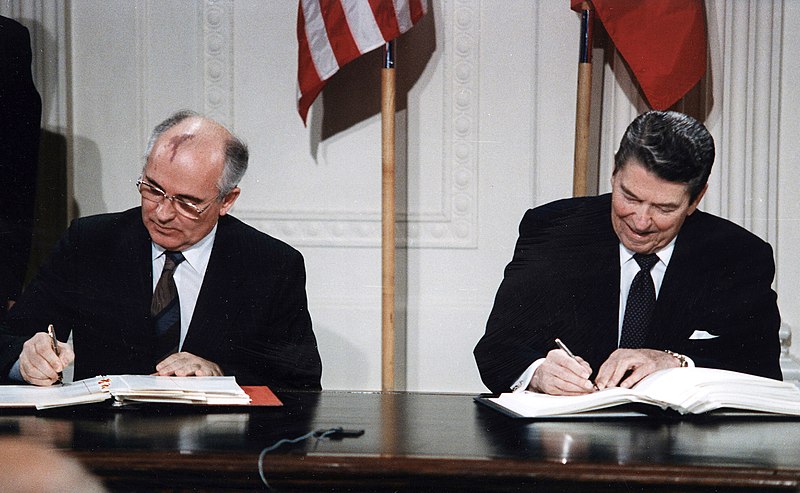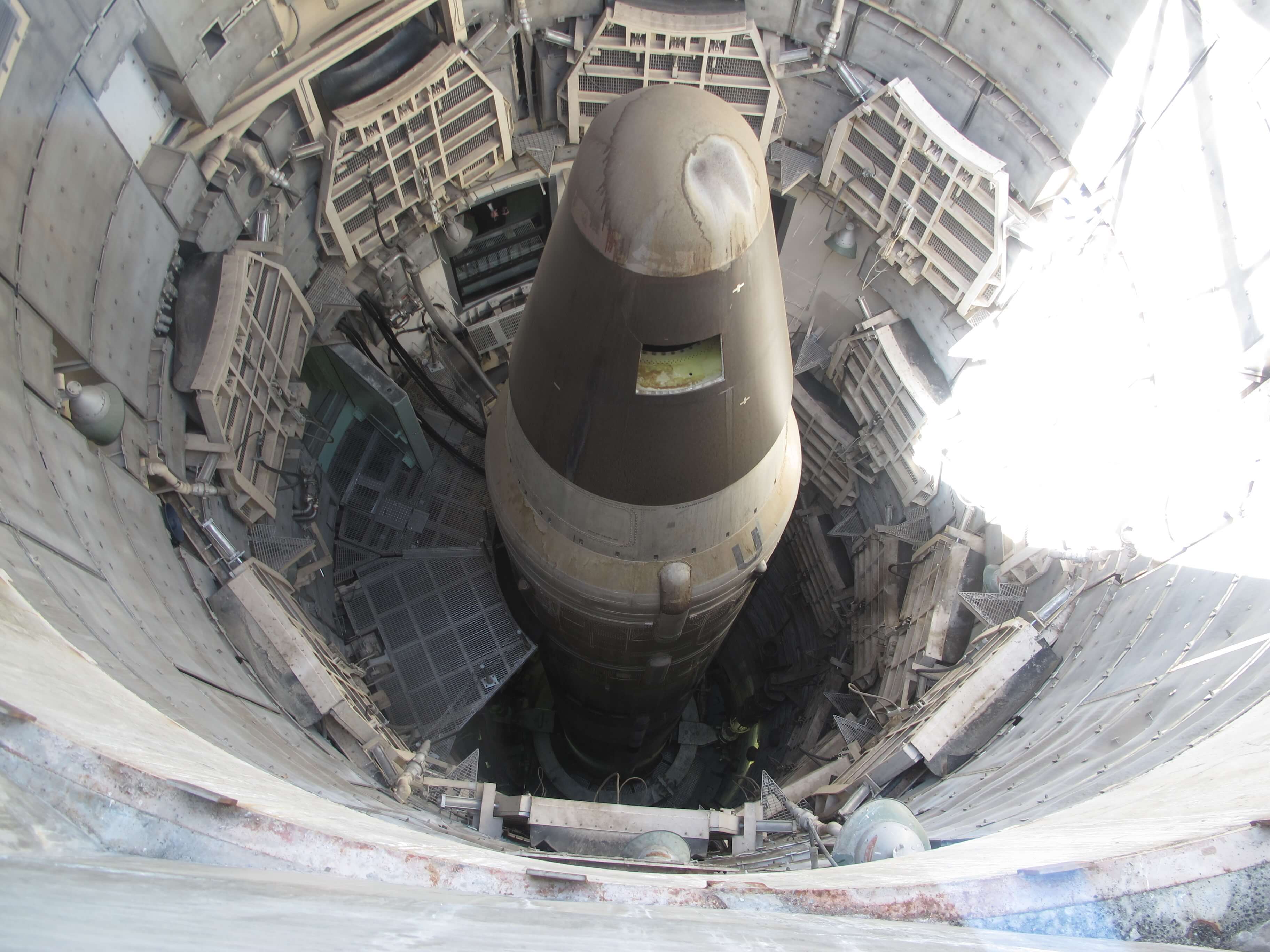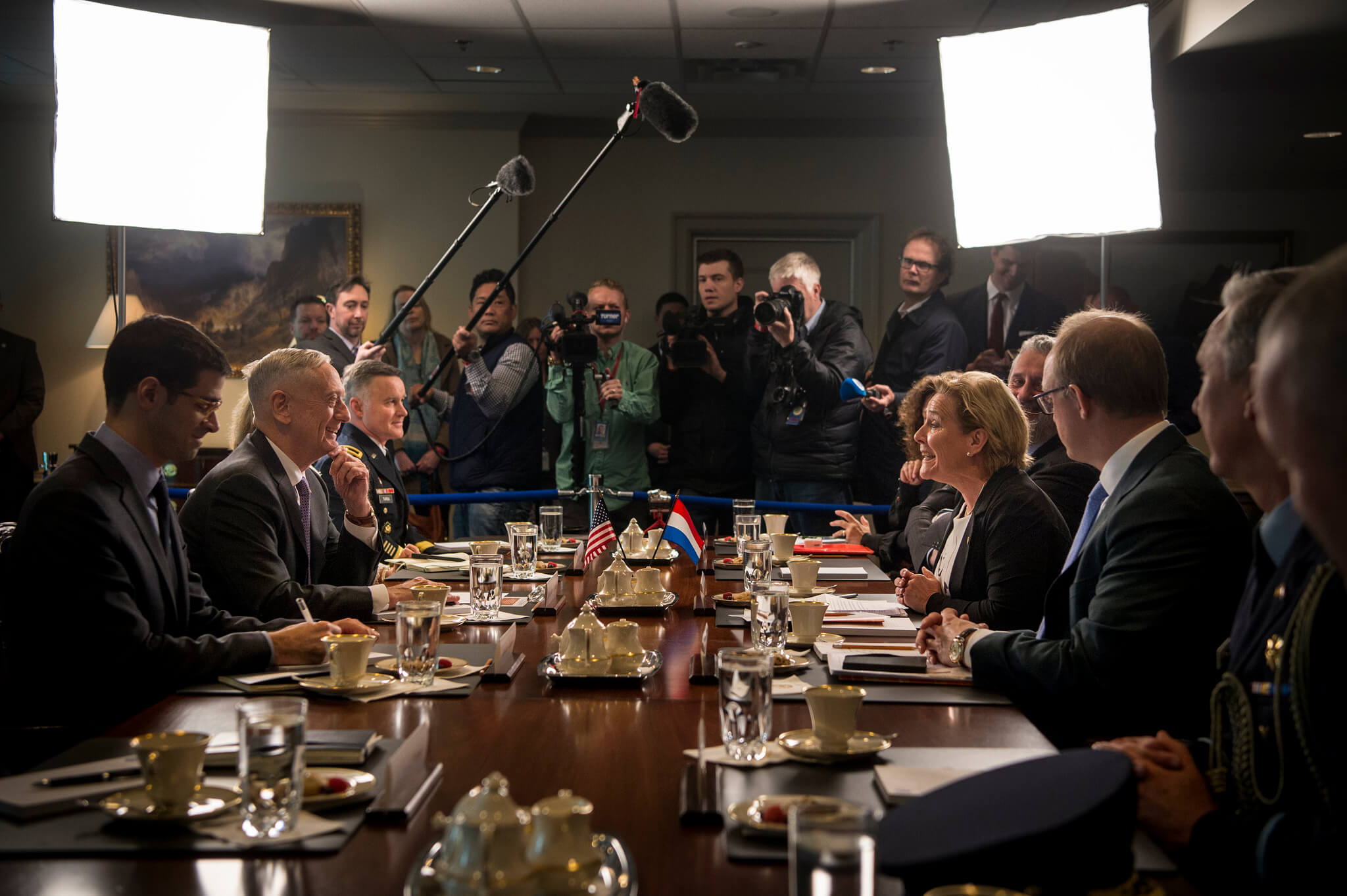Wanted: Great minds who can prevent a new arms race
Entirely as expected, the INF Treaty is now a thing of the past. Officially not yet absolutely a thing of the past, because the US and Russia could still change their minds before 2 August 2019, but this chance is regarded as minimal. Both countries have levelled accusations of violations, but they also have an underestimated shared interest in a new version of arms control under which at the very least China, which may now also be counted as a prominent intermediate-range nuclear missile power, would also be committed to limits. This has not been the case since 1987, when the old INF Treaty was signed by Reagan and Gorbachev.
While China’s nuclear capacity must also not be overestimated, the proliferation of INF missiles to (within ten years perhaps) a dozen countries does expose what is in essence a bilateral treaty from 1987 to obsolescence due to age. The INF discussion requires cool-headed answers to different questions. This is by no means automatic in the understandable emotion of indignation (‘pacta sunt servanda!’).

Violation or not?
The first question is whether there is actually a violation, and if so what and whose it is. The second question is what answer is most desirable, from both a European (or Dutch) perspective and a (total) arms control perspective. The answer to the first question is not usually a matter for discussion and appears a formality: since 2014, the US has been accusing the Russians of violating the INF Treaty by deploying a ground-launched cruise missile with a (prohibited) range of more than 500 km. In December 2017, the US said it was sure of its facts and its NATO allies support the accusation.
The NATO partners also stood squarely behind the American accusation, own verification or not, at the latest NATO Ministerial Council, and there is no sign yet of independent confirmation. The Russians have responded with denials and it is only since the end of December that Moscow has admitted the existence of a cruise missile at all, and since 23 January 2019 it has been saying that the expected weapon has a (permitted) range of 480 km.[fn]AFP, “SCC-8 range less than 500 km”[/fn]
"Now intelligence services always keep their cards close to their chest, so we will probably never know from them whether there is any conclusive evidence of violation."
This happened at the end of November, shortly before the clarification by the head of the American intelligence services Dan Coats, which suggested that it is probably a case of indirect evidence assembled from two separate tests that together produce a prohibited result. [fn] Kamberbrief, 'Nederlandse conclusie over de Russische schending van het INF-verdrag', 27 November 2018.[/fn]
In its recent report, the Advisory Council on International Affairs (AIV) also refers to ‘belief’ and not ‘evidence’ and in its recommendation talks of ‘the Russian violation’ and its potential consequences.[fn]Zie Ko Colijn, 'Wat zit er achter de Nederlandse onthulling over de Russische raketten?', 25 January 2019 en DNI, 'Director of National Intelligence Daniel Coats on Russia's Intermediate-Range Nuclear Forces (INF) Treaty Violation', 30 November 2018.[/fn] Now intelligence services always keep their cards close to their chest, so we will probably never know from them whether there is any conclusive evidence of violation.
The same in fact applies a fortiori to Russian counter-accusations; just one American source attaches any value to the accusation that missile defence installations in Eastern European NATO countries may also be suitable for launching cruise missiles.[fn]Th.Postol: The Nation, https://www.thenation.com/article/russia-inf-nuclear-treaty-aegis/[/fn] Violating international treaties is a last-gasp event with potentially very serious consequences, so it is really unsatisfactory that 100% certainty about this cannot be provided and we have to rely on the belief in secret assurances rather than full evidence from the intelligence community.
The stress placed in this particular case on the ‘independent’ quality of Dutch intelligence has the – painful – background that in around 2002-2003 the Dutch decision to support the military invasion of Iraq was based in part on false information from intelligence services abroad, and is understandable, but that does not solve the problem of furnishing proof.
How to act?
A blessing in disguise is that in answering the second question (how to respond) it is not so much a case of whether and by whom the INF Treaty of 1988 (when it came into force) has been violated. After all, both parties, the US and Russia (as successor to the USSR), share an interest in updating the outdated treaty. In any case, the addition (by 2030 perhaps) of a dozen new countries with INF weapons would now be pertinent. In particular, there is nothing to stop unbridled proliferation to China and South Asia in the current situation, for the simple reason that these countries were not party to the old INF Treaty. Nor did or do they feel anything for it: a joint attempt by the US and Russia in the UN Security Council to multilateralise the treaty in 2007 came to nothing.[fn]U.S. Department of State, 'Joint U.S.-Russian Statement on the Treaty on the Elimination of Intermdiate-Range and Shorter-Range Missiles at the 62nd Session of the UN General Assembly', October 2007.[/fn]
It is not implausible that Putin drew the conclusion from this that development of weapon systems, although contrary to the INF Treaty, was logically defensible and could also be disguised by using or misusing the loopholes in the text of the treaty. Nor is it implausible that Russia felt this need more keenly than the US, which does not share a land border with China and the rest of Asia (nor Russia), and did not have any INF problem as such that could not be legally covered by other means (sea launched and air launched).
Of course, this does not justify a Russian violation because, indeed, pacta sunt servanda. The fact is that up to October 2018 the US, despite persistent accusations, always maintained that American termination of the INF Treaty as a response to the alleged Russian violation was unnecessary. Diplomatic, economic and even military countermeasures would be enough, while various American experts even argued that from a military viewpoint, termination of the treaty would not only be unnecessary, but also counterproductive. Matt Korda and Hans M. Kristensen provide a summary of this in their article 'Trump falls on sword for Putin's Treaty Violation'.[fn]The Bulletin, 'Trump falls on sword for Putin's treaty violation', 29 October 2018.[/fn]
The decision by President Trump – soon followed by the clarification in Moscow by his National Security Adviser Bolton – on 20 October 2018 to set termination of the treaty in motion was in that light a break with the policy agreed upon earlier that month in Nato not to take the decision before 4 December 2018 and to give the allies the opportunity to come up with constructive suggestions. The American Minister Jim Mattis, who had presented the ‘constructive suggestion’ route to NATO on 4 October, was therefore passed over and has since been forced to step down.
The rest is now history: pleas from the allies (Germany, the Netherlands and some other countries) did lead to a 60-day postponement, in the form of an ultimatum to Russia – which was tightened up by Andrea Thompson from ‘back in compliance’ to the requirement of ‘destruction of all missiles and related equipment’.[fn]France24, 'Nuclear arms treaty faces collapse after failed US-Russia talks', 15 January 2019.[/fn] A satisfactory Russian response failed to materialise and the curtain came down on 2 February 2019.
Immediately after 2 February Russia in its turn responded by terminating its obligations and announcing new weapon systems banned under the old treaty. This does not of course rule out both parties reaching a compromise during the six-month termination period, but a solution of the ‘China problem’ before that time is unlikely.
The question now is whether the termination by the US on 2 February last was a sensible move. Definitely, believes the American ambassador to NATO, Kay Baily Hutchinson. In the article Blame Russia if the Treaty Dies, she writes: “a treaty cannot exist when one side complies and the other does not.”[fn]New York Times, 11 February 2012, print[/fn], a truism of course and a formula that was repeated to the letter by NATO chief Jens Stoltenberg on 13 February.
Nevertheless, Korda and Kristensen strike a different note when they write that – even if Russia is violating the treaty – it is not in the interest of the US and its (European) allies to withdraw from it. In this reasoning it is unwise to give Putin a valid excuse for free to develop and deploy previously banned intermediate-range weapons, thereby almost certainly launching an arms race and exacerbating the climate for renewal of New START (which curbs intercontinental weapon systems). When all is said and done, in 2021, there is the threat of an era without arms control emerging for the first time since the 1960s. On the basis of statements by American generals, Korda and Kristensen explain that the US has enough weapons to ward off the Russian and Chinese threat, the termination of the INF Treaty is unnecessary and the US is ‘depriving’ itself of the moral advantage to keep putting the Russians under pressure and adhere to the treaty. “Moral equivalence” is of course served by the decision to withdraw from the treaty, but more important is that it would not promote security in this situation.[fn]Korda, Kristensen, op.cit[/fn]

Perhaps it is not just moral equivalence, but other considerations too that played a part. The most cynical is that Trump and co are entirely self-confident in their belief that a nuclear arms race can be won, in the way that Ronald Reagan impressed the Soviet Union with SDI and brought it to its knees in the 1980s. Not very convincing, but certainly current, is the argument that the US now has its hands free and the threat from China can be made harmless with GLCMs from Guam. Critics – even among the American top military brass itself – however say that there are enough sea and Japan-based weapons to control Chinese missile installations on the Chinese mainland. Whether this will be true in the future too remains the question.
"An optimal scenario for Europe would be when the road to arms control can be regained and a multilateralisation of the INF-Treaty could take place"
A more credible argument in our view is that the US, speculating on the military superiority it certainly still has globally, can translate this superiority in a post-INF world into a more favourable negotiating position in respect of North Korea, China, Iran and other countries in the interest of a multilateral INF Treaty 2.0. A high-risk strategy that sacrifices the interest of Europe to the interest that the US attaches to its (and Trump’s) ambition to win the great power competition declared by the US, if necessary through ‘outspending’ and ‘outinnovation’[fn]In the words of Trump, State of the Union, 6 February 2019.[/fn]
In each of the cases described Europe would be the loser because the old INF Treaty has protected the European subcontinent from ground-launched intermediate-range missiles for 30 years. The American calculation may be that this can be overcome with existing weapons that fall outside INF limits. It could be done with a mix of offensive and defensive weapons.[fn]For a menu of answers, see also Dick Zandee, 24 January 2019.[/fn]

A deterrence option has been suggested in the NPR 2018, by putting sea and air-launched weapons on standby and, as a bargaining chip, setting aside money for the development of a new ground-launched cruise missile. A nuclear version of a ground-launched weapon system would not be in the offing: senior officials have from the outset denied such a plan. And at the recent NATO Ministerial Council, Stoltenberg said: ‘ (And) we do not intend to deploy new land-based nuclear missiles in Europe’.[fn]Press conference by NATO Secretary General Jens Stoltenberg following the meetings of NATO Defence Ministers, 13 februari 2019[/fn] The Dutch Minister of Defence Ank Bijleveld went a step further than Stoltenberg after the same meeting on 13 February 2019 by commenting on the radio that ‘as far as I’m concerned, I’m completely clear about it: no missiles in Europe,’ so no conventional missiles either.[fn]https://www.nporadio1.nl/nieuws-en-co/uitzendingen, 13 February 2019, 18.00-18.30[/fn] This total renunciation of missiles on NATO territory in Europe could in fact be a response to Putin’s threat of 24 October 2018 that in that case retaliatory measures would be inevitable.[fn]25-10-20 Putin: Russia will target nations who host New American nuclear missiles - "The European nations that would agree to that should understand that they would expose their territory to the threat of a possible retaliatory strike. These are obvious things."[/fn]
Defensive countermeasures include (the expansion of) missile defence installations on the NATO side. Providing little enlightenment, among insiders rather creating disbelief, was that at the beginning of October the American NATO ambassador Hutchinson had even dared to speak of ‘taking out’ (eliminating) Russian missiles and had described their threat as ‘ballistic’, which the SSC-8 patently is not. [fn]Kay Baily Hutchinson 2 October 2018 ‘They are building a medium-range ballistic missile in violation of the INF. That is a fact which we have proven’[/fn]
Best-case scenario's?
Better, and for Europe the best possible, would be a scenario where the arms control route can be rediscovered and there would be multilateralisation of the INF Treaty. Even if China is not interested in this, it might perhaps be possible to design a regional variant by which Europe is protected from intermediate-range systems. Russia, the US and China could all agree on a configuration of systems ‘beyond’ the Urals, but maintain the old European zero option. Strict verification measures would then be required to guarantee that the mobile systems are not moved within Europe’s range. Technically difficult and expensive, but security has its price.[fn]See Ko Colijn[/fn]
Even then we are not there yet in 2019. According to some experts, the deployment of short-range missiles in Western Russia, in particular in the exclave Kaliningrad, would make salvaging the INF Treaty nothing more than a symbolic success. Warsaw, Berlin and the Baltic countries would, after all, have reason for concern because they lie within the range of weapons such as the Iskander-M, which is dual-capable and said to be ‘immune’ to both old INF bans and military countermeasures.[fn]The National Interest,'Russia's Deadly Iskander-M Ballistic Missile is Headed to Kalingrad Exclave', 2 January 2019.[/fn] They in their turn are of course vulnerable to interdictory NATO artillery and other preventive deployment of weapons, but that would have a destabilising crisis effect. Countries such as Germany and Eastern European NATO member states therefore have a direct interest in arms control at the level of these short-range systems, preferably a zero solution.
The introduction of blurring (and entangling) weapon systems, makes verification – a key condition for effective arms control – very complicated. This introduction – nothing new but assuming major proportions, such as the introduction of the B61-12 bomb under the F35 that can turn this aircraft into a semi-strategic weapon – may be justified on military-operational grounds, but creates just as many problems and will hugely complicate nuclear arms control by crossing established lines between relevant weapon categories. An orthodox plea for ‘continuation of the current DCA task of the F16’ or ‘retention of the INF Treaty’ therefore falls short: the assessment is more subtle and more complex. But: the common interest of arms control is clear, that much rivals the US and Russia and China cannot deny. But extremely creative minds are required to save us an expensive and ultimately meaningless arms race.

